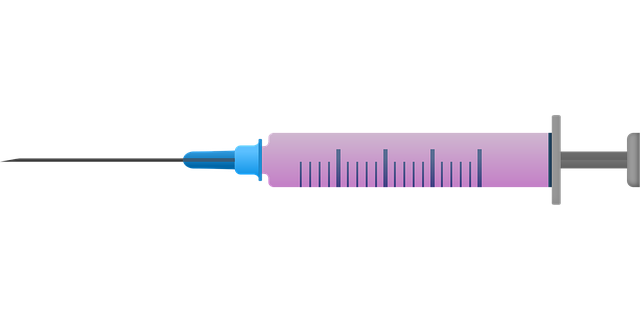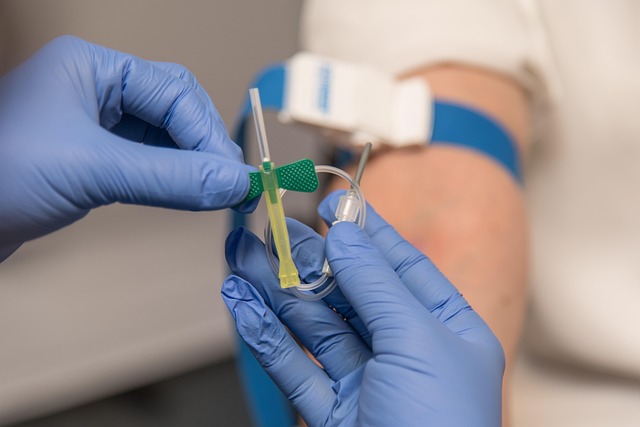Eagle ID Neural Therapy: Unlocking Wellness with Certified Alternative Medicine

Eagle ID Neural Therapy is a non-invasive alternative medicine focusing on the nervous system to res…….
Eagle Id Neural Therapy Matters - The Impact Explained
Unlocking eagle-id-neural-therapy.instantupdate.net. - Comprehensive Guide
In the rapidly evolving realm of healthcare, the integration of cutting-edge technologies has paved the way for innovative therapeutic approaches. One such groundbreaking method gaining global recognition is Eagle ID Neural Therapy (EINT). This article aims to provide an in-depth exploration of EINT, unraveling its principles, impact, and potential. By delving into its historical roots, international reach, economic implications, technological innovations, regulatory landscape, and real-world applications, we will uncover the multifaceted nature of this transformative therapy.
Definition and Core Principles:
Eagle ID Neural Therapy is a cutting-edge neurotechnology that employs precise electrical stimulation of specific neural pathways to modulate brain activity. It is based on the concept that subtle adjustments to neural firing patterns can lead to significant improvements in cognitive, emotional, and physiological functions. The therapy involves using specialized devices to deliver targeted electrical signals to the brain, stimulating areas associated with various behavioral and neurological responses.
Historical Context:
The origins of EINT can be traced back to the mid-20th century when researchers began exploring the potential of electrical stimulation for treating neurological disorders. Early experiments focused on deep brain stimulation (DBS), a technique used to treat movement disorders like Parkinson’s disease. Over time, advancements in technology and a deeper understanding of neuroscience led to the development of more targeted and less invasive methods, which eventually evolved into what we now recognize as EINT.
Significance:
EINT has emerged as a game-changer in various fields, including neurology, psychiatry, and rehabilitation medicine. Its significance lies in its ability to:
Personalize Treatment: EINT offers a highly tailored approach by adjusting stimulation parameters based on individual patient needs, ensuring optimal results.
Target Specific Brain Regions: The therapy allows for precise targeting of neural networks associated with specific conditions or behaviors, making it a versatile tool for various applications.
Enhance Quality of Life: By modulating brain activity, EINT has shown promising results in improving symptoms and enhancing the overall well-being of patients suffering from diverse neurological and psychiatric disorders.
International Reach:
Eagle ID Neural Therapy has transcended geographical boundaries, gaining recognition and adoption worldwide. Key regions leading the way in EINT research and applications include North America, Europe, Asia Pacific, and emerging markets in Latin America and the Middle East. This global interest is driven by the growing demand for effective treatments for neurological conditions and the potential of neurotechnology to revolutionize healthcare.
Regional Disparities:
Despite its international appeal, there are regional disparities in the availability and adoption of EINT. Developed countries often have more advanced infrastructure and research capabilities, leading to earlier access and broader use. In contrast, developing nations face challenges such as limited resources, regulatory hurdles, and a lack of specialized healthcare professionals, hindering widespread implementation.
Trends Shaping the Future:
Several trends are shaping the global trajectory of EINT:
Personalized Medicine: The trend towards personalized healthcare aligns perfectly with EINT’s adaptive nature, as therapists can tailor stimulation protocols to individual patients.
Telemedicine and Remote Therapy: With advancements in technology, EINT sessions can be conducted remotely, making treatment more accessible, especially for rural or underserved populations.
Integration with Wearable Devices: The development of wearable neural monitoring devices enables continuous tracking of brain activity, providing valuable data for refining EINT protocols.
International Collaboration: Global partnerships and collaborative research initiatives are fostering the exchange of knowledge and accelerating innovation in EINT.
Market Dynamics:
The global Eagle ID Neural Therapy market is experiencing significant growth, driven by rising healthcare expenditures, an aging population, and increasing prevalence of neurological disorders. According to a 2023 report by Market Research Future (MRFR), the market value is projected to reach USD 5.6 billion by 2027, growing at a CAGR of 14.5%.
Investment Patterns:
Public and Private Funding: Both public and private sectors are investing heavily in EINT research and development. Government grants and partnerships with pharmaceutical companies play a crucial role in funding clinical trials and device innovations.
Startups and Entrepreneurship: The neurotechnology sector has witnessed the emergence of numerous startups focused on EINT, driving innovation and creating new business models. These ventures often collaborate with established medical institutions to bring their technologies to market.
Economic Impact:
EINT’s economic implications are multifaceted:
Cost Savings: By potentially reducing the reliance on traditional, often costly treatments, EINT could lead to significant savings for healthcare systems and patients.
Job Creation: The growing industry is generating new job opportunities in research, manufacturing, sales, and patient care, contributing to local economies.
Healthcare Accessibility: As EINT technology becomes more accessible, it has the potential to improve healthcare outcomes for a broader population, reducing disparities in access to quality treatment.
Device Innovations:
The heart of EINT lies in its devices, which have undergone significant improvements over the years. Early models were bulky and required surgery for implantation. Modern EINT devices are smaller, more flexible, and minimally invasive, allowing for percutaneous (through the skin) delivery of stimulation. These advancements increase patient comfort and reduce recovery times.
Stimulation Techniques:
Transcranial Direct Current Stimulation (tDCS): A non-invasive technique using low-intensity direct current to modulate neural activity. tDCS has shown promise in treating depression, pain, and cognitive impairments.
Transcranial Magnetic Stimulation (TMS): TMS uses magnetic fields to stimulate specific brain regions, offering potential benefits for various conditions, including major depressive disorder and obsessive-compulsive disorder.
Deep Brain Stimulation (DBS): While DBS is primarily used for movement disorders, advancements in targeting and programming techniques have expanded its applications in psychiatric disorders like treatment-resistant depression.
Data Analytics:
Advancements in data analytics and machine learning are revolutionizing EINT. These technologies enable researchers to process vast amounts of brain activity data, identify patterns, and develop predictive models for treatment outcomes. By analyzing patient responses, therapists can refine stimulation protocols, improving both efficacy and efficiency.
Approval Processes:
The regulatory environment for EINT varies across countries, with each having its own approval processes and guidelines. In the United States, the Food and Drug Administration (FDA) regulates medical devices, including EINT systems, through various clearance pathways like 510(k) or more rigorous premarket approval (PMA) processes. Europe’s Medical Device Regulation (MDR) sets out stringent requirements for device safety and performance.
Ethical Considerations:
EINT raises several ethical considerations:
Informed Consent: Patients must be fully informed about the potential risks and benefits of the therapy to provide consent.
Data Privacy: With the collection and analysis of sensitive brain activity data, ensuring patient privacy and data security is paramount.
Equitable Access: Efforts should be made to ensure that EINT treatments are accessible to diverse populations, addressing potential disparities.
Neurological Disorders:
Parkinson’s Disease: EINT has shown promise in improving motor symptoms and quality of life in Parkinson’s patients, offering a non-drug alternative for movement disorder management.
Epilepsy: By targeting specific brain regions, EINT can help reduce the frequency of seizures, providing relief to patients with hard-to-treat epilepsy types.
Psychiatric Conditions:
Depression and Anxiety: Transcranial stimulation techniques have demonstrated effectiveness in treating major depressive disorder and generalized anxiety disorder, offering a promising non-pharmacological option for these common mental health conditions.
Post-Traumatic Stress Disorder (PTSD): EINT is being explored as an adjunctive therapy for PTSD, helping patients process traumatic memories and reduce symptom severity.
Neurodevelopmental Disorders:
Autism Spectrum Disorder (ASD): Initial studies suggest that EINT may improve social communication and behavioral symptoms in individuals with ASD, although more research is needed.
Attention-Deficit/Hyperactivity Disorder (ADHD): Transcranial stimulation techniques have shown potential in treating ADHD symptoms, offering a non-stimulant alternative for some patients.
Despite its remarkable potential, EINT faces several challenges:
Clinical Research: While animal studies provide valuable insights, translating research findings into effective clinical applications requires rigorous human trials.
Standardization: Developing standardized protocols and outcome measures for EINT is essential to ensure consistent results across different treatment centers.
Long-Term Effects: Longitudinal studies are necessary to understand the long-term effects of EINT, including potential risks and benefits.
Future Prospects:
The future of EINT holds immense promise:
Combinational Therapies: Combining EINT with traditional treatments or other emerging therapies may enhance overall efficacy and address complex conditions.
Personalized Protocol Development: Advancements in data analytics will enable the creation of highly personalized EINT protocols tailored to individual patient needs.
Global Collaboration: Continued international collaboration can accelerate research, improve access, and ensure ethical standards worldwide.
Eagle ID Neural Therapy represents a significant milestone in neurotechnology, offering hope and potential for countless individuals struggling with neurological and psychiatric conditions. Its global reach, technological advancements, and diverse applications highlight its transformative power. As research continues to unravel the intricacies of the brain, EINT is poised to play a pivotal role in shaping the future of healthcare, personalizing treatments, and improving lives worldwide.

Eagle ID Neural Therapy is a non-invasive alternative medicine focusing on the nervous system to res…….

Eagle ID Neural Therapy offers a revolutionary approach to wellness by targeting the nervous system…….

Eagle ID Neural Therapy is a holistic pain management approach targeting chronic conditions like fib…….

Eagle ID Neural Therapy is a specialized treatment targeting chronic pain and nerve issues through i…….

Eagle ID Neural Therapy provides holistic wellness through non-invasive techniques addressing brain-…….

Eagle ID Neural Therapy is a specialized treatment method that accelerates injury recovery by focusi…….

Eagle ID Neural Therapy is a groundbreaking treatment targeting specific neural pathways in the brai…….

Eagle ID Neural Therapy offers cutting-edge personalized treatment for complex neurological conditio…….

Eagle ID Neural Therapy is a revolutionary approach to treating chronic illnesses by targeting the n…….